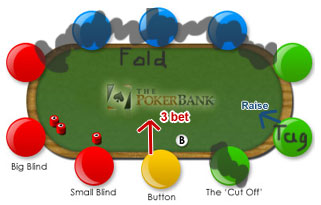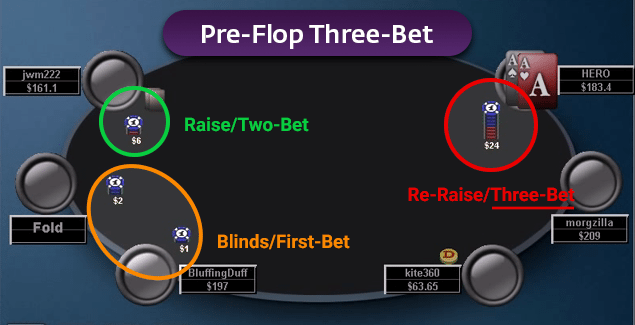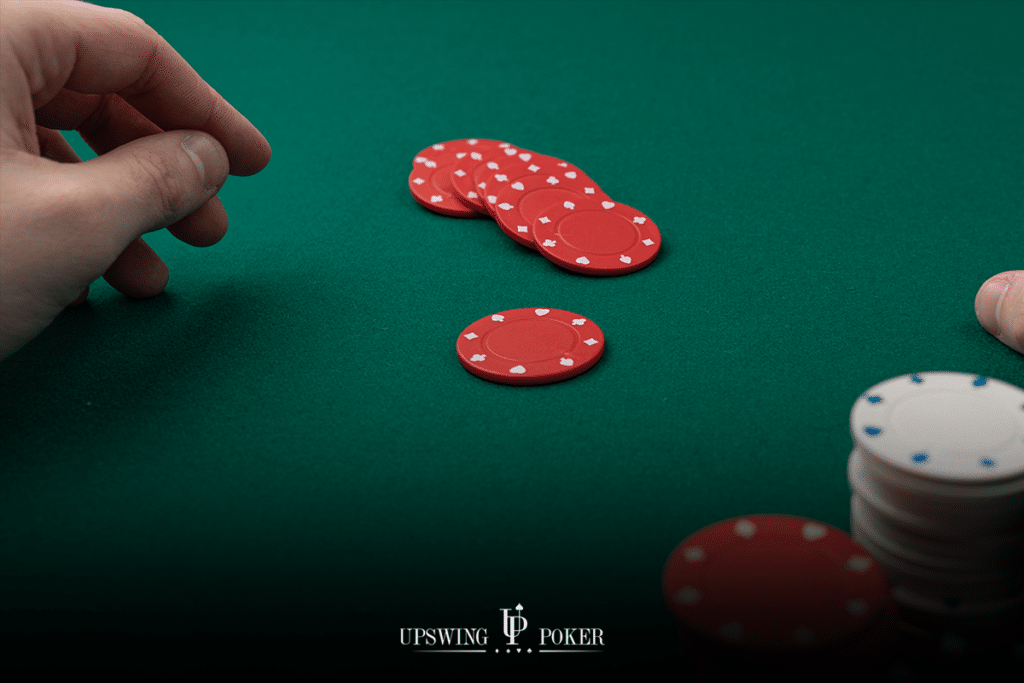Poker When To 3 Bet
In poker, a '3bet' occurs when there is a bet, raise and re-raise. The re-raise is the '3bet'. For instance - let's say that you are playing in a cash game. Jan 01, 2017 The purpose of a value 3-bet is simply to get called by a decent selection of worse hands in order to make money. The purpose of a bluff 3bet is to take the pot down preflop. We know that we usually do not have the best hand, but if our opponent sometimes folds, we can profit. The purpose of a value 3-bet is simply to get called by a decent selection of worse hands in order to make money. The purpose of a bluff 3bet is to take the pot down preflop. We know that we usually do not have the best hand, but if our opponent sometimes folds, we can profit.
A bet from a player on the flop who raised pre-flop is known as a continuation bet or simply a c-bet. That player has continued to seize the initiative, hence the term, continuation bet. The normal use of the continuation bet is by a player in position against a lone opponent who has checked on the flop. The use of a continuation bet is rooted in the wisdom that most of the time one’s hand does not improve on the flop. Therefore the first player to bet may take down the pot right then and there.
Over time the use of this strategy has almost become the 100% default action by many poker players. Right up front we will state that if players employ this poker strategy every time they have taken the lead pre-flop, they are continuation betting too frequently. When this is the case, what can be utilized selectively to one’s benefit can become a major leak. As in all of poker, predictability is analogous to stepping into the cross hairs of all but your most obtuse opponents.
A 3-bet occurs when the original preflop raiser is re-raised by another player. A 4-bet occurs when a 3-bet is re-raised by any player. A 3-bet is when there has been a raise and then another raise after that. Simple enough, but let me give you one quick example to drive it home: After the SB and BB post the $1 and $2 blinds, lets say there is a raise to $8 from a player in MP. If another player in LP raises it again to $24, this is called a 3-bet.
In this lesson we will attempt to explore the why, when and against whom this action should ideally be taken. We will also recommend some counter strategies for when your opponent is the one making a continuation bet.
The Purpose of Continuation Bets
As stated above, the strategy is based upon the fact that a hand is not usually improved upon by the flop so attacking your opponent with further aggression, regardless of your holding, can many times win the pot. It can also be used a reverse bluff when you hold a strong hand and would like to build the pot. The main purpose, however, is to win the pot immediately.
The Number of Opponents
The fewer opponents you are facing the higher your chances of success in winning the pot with a continuation bet. As a general guide, consider the following:
- C-bet almost 100% when heads up
- C-bet 50% when against two players
- C-bet 25% when against three players
Continuation betting against more than one opponent, while much less frequently, gives your game a degree of unpredictability. Although if there are four or more players then you’ll probably want to have hit the flop before sending more chips toward the middle – and a check may be in order.
The Texture of the Board
As the Mad Genius of Poker, Mike Caro, has stated… hold’em is a game of high cards while stud is a game of live cards. Keeping that counsel in mind, if the flop comes Jack, Queen and King there is a high likelihood that one of your opponents may well be holding a match to one of these wheel house cards. They weren’t calling your pre-flop raise with 6-3 offsuit!
The texture of the flop is critical to whether a c-bet is the play with the best expectation. Aside from high cards, be careful of coordinated boards that favor straight and flush draws. Ideally, you’ll want to see a ragged, rainbow flop.
Let’s look at a few examples. Suppose you raise with and get called by the button and the blinds. The flop comes :

Figure 1
This is not a good spot to c-bet. You’re against three opponents and your hand value is only an inside straight. You missed your high cards and flush potential and one of your opponents could have easily connected with such a flop. If checked to, then check and hope you get a free look at the turn. If you bet and then get raised by the button or check-raised by one of the blinds, you would have to fold, so see if you can hit your draw on the turn.
Let’s suppose you’re holding the same hand, yet this time you’re against a single opponent and the flop is dealt :
Figure 2
This is a completely different situation and if your opponent checks it’s a great time for a semi-bluff c-bet to either take the pot right then or if called you have two overs and the second nut flush draw. If you were facing more than one opponent then it would also be a good time to make a continuation bet, unlike the previous example.
You can also make a continuation bet when you flop a very strong hand, such a set. Remember that in poker it’s important to play different hands the same way. If you regularly make continuation bets when you whiff on the flop, you should also bet when you make a strong hand too – so as not to arouse suspicions. Your intention in poker is to manipulate your opponents and one advantage of frequently c-betting is that you will give your good hands some cover and disguise.
Bet Sizing
If you’re playing no-limit hold’em then you will also need to decide the size of your wager when planning a continuation bet. Many factors should contribute to your decision including: opponent playing tendencies, stack sizes and your own table image. You need to balance your bet size for two reasons. Understanding that the strategy is not fool proof… you don’t want to bet too small which will invite a call and to bet too large becomes foolhardy.
But it’s important to be consistent with your betting. Therefore your continuation bets should be the same size as any other post-flop betting and conventional wisdom seems to favor a bet size of at least half the pot. To bet less extends better calling odds to your opponent and to bet more becomes too costly when you run into an opponent that actually has a hand. This is not a hard and fast rule and you’ll find yourself making adjustments through experience, feel and the general nature of the game.
Pokerstars 3 Bet
Your Opponents
While it is true that knowledge of how you believe your opponents will react is a universal poker criteria to successful play, when betting into an opponent with nothing, it is good to know how tight or loose he may tend to play.
In addition, just as you are making a play so may be your opponent. Is he savvy enough to be floating you? This is a play in which your opponent may suspect you are continuation betting so he just flat calls expecting you to check on the turn. If you do check after he calls your continuation bet, his intention is to seize upon your apparent weakness and bet to steal the pot.
The factors outlined above are the major criteria one should evaluate to determine the wisdom of making a continuation bet. In a perfect situation you should be in position against a single weak/tight opponent making a bet of about half the pot into a raggedy board. The half pot bet will offer him 3-to-1 odds which aren’t very good drawing odds. If you know your opponent is knowledgeable regarding drawing odds, this becomes a positive to offering him poor odds to a possible draw.
Countering the Continuation Bet
Poker Hands To 3 Bet With
Now let’s take a look at the same situation in the mirror. Instead of aiming the shotgun at a lone opponent, we’ll imagine you are looking down the barrel of the continuation better. At the risk of sounding like a broken record, always be observant of your opponents in order to improve your decision making. Is he aggressive and loose or timid and tight or where in that range does he dwell? You know many players love to see a flop and then feel compelled to fire a continuation bet to end the action. Know your opponent’s tendencies – this knowledge pays dividends.
Reverse Engineering
Reverse engineering is a term used in many fields to describe a process wherein you first dissect a competitor’s product, marketing plan or just about anything in order to determine how it’s made or done with the intention of replicating it or improving upon it. The best way to combat an opponent who is continuation betting is to understand his thought process and, if appropriate, play back at him. Review the following checklist to determine if you’re being manipulated by an opponent’s continuation bet.
- Does he regularly, therefore predictably, continuation bet?
- Does his bet warrant a call based upon your hand?
- Based on his tendencies, is attempting to steal the pot?
- If he is stealing, should you raise, call, or fold?
Identifying the Meaning of Your Opponent’s Bets
There are many different types of bets in addition to continuation bets… value bets, probe bets, and semi-bluffs as examples. There is nothing worse than attempting to thwart what you believe is a continuation bet by calling all the way to the river only to face the ultimate revelation that your opponent was value betting the whole time.
Knowledge is power and it is up to you to observe your opponents betting patterns to understand just how they play the game. It is this knowledge that will help guide you to making quality decisions and when all is said and done – making quality decisions is what separates the winners from the losers.

Conclusion

Continuation betting is a solid poker strategy to employ when the criteria outlined above is in place. However, it should represent only one arrow in your quiver of ploys. As in all of poker, don’t use it every time you have been the pre-flop aggressor as you will become predictable and, therefore, exploitable. Instead, observe your opponents and determine who among them does not understand the wisdom of mixing up one’s game.
Related Lessons
By Tom 'TIME' Leonard
Tom has been writing about poker since 1994 and has played across the USA for over 40 years, playing every game in almost every card room in Atlantic City, California and Las Vegas.
Three betting light is a skill that will help any player effectively balance their range and steal pots. On the other hand, light three bets could also end up costing you a fortune. The key to success with light three bets is the ability to properly identify which situations will be profitable and which will not.
There are a number of players who make light three bets for the sake of making light three bets. Needless to say, this is not the optimal strategy. You need to know who you are trying to push out of the hand, what you are trying to represent, your image at the table, and how you will react to a call or shove.
These are the basic dynamics that need to be understood if you want to make your three bets profitable. Three betting light is a challenge because it requires that players have a fair amount of experience and a natural feel for the game. This is one of the tools that is not so much taught as it is learned. Once you are able to work light three bets into your NL Hold'em game, though, you will be that much more dynamic.
Who You Want to Fold
The players who you want to fold when making a light three bet will often determine whether or not the play is worth attempting. If the two loosest players in the world have made an open raise and call, the odds of you getting them both to fold with a light three bet are far from good. If two moderately tight players did the same exact thing, however, you would be in much better shape.
Poker When To 3 Bet Slot Machines
Don’t get confused, though, as two super tight players would also be indicative of a generally weak spot for a light three bet. You should be three betting light against players who are capable of opening with decent hands, but will also be playing something that is not good enough to call a three bet.
There is no exact science to determining what hands you are up against, so it comes down to being right more often than you are wrong, as is often the case with any play in NL Hold'em.

The Hand You’re Representing
You need to know exactly what you are trying to tell your opponents when you make a light three bet. Do you want them to think you have an absolute monster, a random suited hand, or something completely different? The hand that you are representing will often determine just how much you should be raising.
For example, a monster hand might make a smaller, yet sizable, three bet in order to squeeze some value out of the other players. A suited hand, however, would be more apt to make a big bet so that it has a reasonable shot at forcing folds from stronger pre flop hands.
Now, since a light three bet implies that your hand neither has strong potential or is already made, you should be picking what you want your opponents to think you have. Make a moderate three bet and play it hard on the flop when representing a big pocket pair, or make a big bet and continue on the flop if you think your opponents are a bit scared. Carefully determine what story you are trying to tell and be sure to stick to it.
Your Table Image
If you want your light three bets to work with any bit of regularity, you need to be able to effectively convince your opponents to fold. The other players might perceive you as super tight and they will think that a light three bet is always going to be with a major hand. On the other hand, your opponents could feel that you are a bit too loose and might be making a play more often than not when you three bet.
The table image that you have is much more important than how you actually play. Consider how your opponents think you play and do your best to exploit that image. Don’t try to be something that you are not - instead try to be something that the other players think you are not.
Poker When To 3 Bet Parlay
Reacting to Calls or Shoves
If you three bet light with any measure of consistency, you will run into spots where the other players either call or re raise. In these situations it is important that you know what you are supposed to do. If you have a weak hand, but have little money left behind, it might make sense to call a shove anyway.
By contrast, a weak hand with a lot of money behind should denote an easy fold. The truly tricky hands will be when you make a light three bet and get called. You shouldn’t give up on the hand just because you were called. Instead, look for ways to win the pot post flop.

If the board is fit for a continuation bet and you feel that your opponent might be capable of folding, go ahead and try to push them out. You might even get lucky and flop a big hand, even if you had nothing pre flop. Planning ahead is crucial in almost any aspect of poker, and light three bets are no exception.